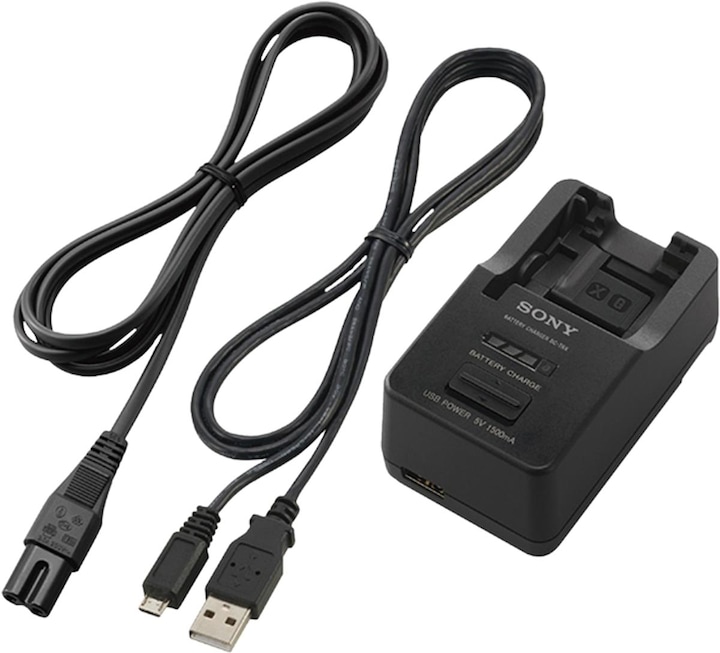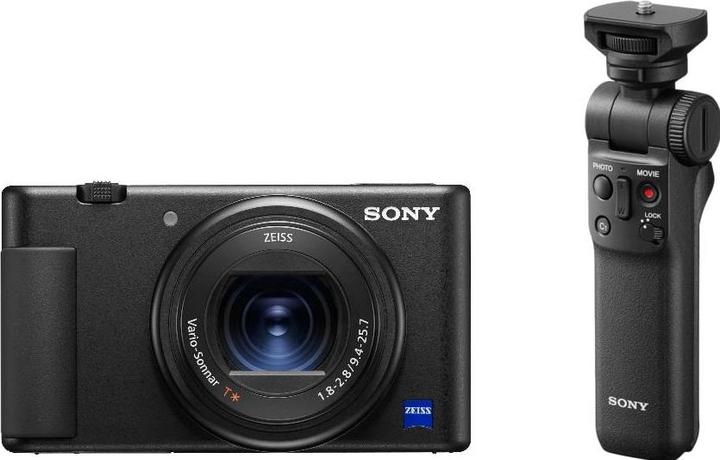

Vlogging: test the Sony ZV-1
With the ZV-1, Sony is launching a new compact camera. Its features and design are similar to the popular RX100 models, but this model is more focused on vlogging.
Modern still cameras are also cameras. But just by picking up a camera, the needs of photographers and video producers are fundamentally different. This is even truer for vlogging, where you record yourself. With the ZV-1, Sony is launching a camera that not only takes vloggers into account, but makes them its main target group. It is expected to be available in early June 2020.

Compared to the compact cameras in the RX100 series, which are roughly the same size, the following differences can be seen:
- the video recording button is the same size as the shutter release and is also on the top;
- a red light on the front panel clearly shows, even from a distance, whether the camera is recording;
- the screen rotates 180 degrees horizontally and can also be tilted;
- an accessory shoe for a microphone or video light.
- a microphone jack (3.5 mm) and a precisely adjustable recording level. Only the latest model in the RX100 series is equipped with this;
- integrated three-capsule directional microphone with windscreen supplied;
- a special button for the bokeh effect.
But the ZV-1 has a few features that the RX100 series doesn't:
- no viewfinder (the space is taken up by the accessory shoe);
- the flash (the space is occupied by the microphone);
- Mode button instead of a scroll wheel (no space because of the video record button and bokeh button) ;
- no rotating ring on the lens. The RX100's rotating bezel is particularly useful in combination with the viewfinder to provide the photographer with an easy to feel control element. Without a viewfinder, it is not essential.

Image quality: as part of the RX100 series
I take a few shots first; I feel more comfortable with the photos. I'm pleased with the image quality, which reflects the well-known expectations of the RX100 series. No wonder: the sensor seems to be the same as on the RX100 V, the processor the same as on the RX100 VII and the lens reminds me strongly of my RX100 III. It offers a focal length of 24-70 millimetres with a speed of f/1.8 to f/2.8. Compared to an RX100, however, I miss the viewfinder when I'm taking photos. As does the ability to tilt the screen without having to unfold it completely.
Until now, Lightroom hasn't been able to process the camera's raw data. So here are two JPEGs.

The windscreen
The included windscreen spontaneously inspires me. As a rule, outdoor videos are ruined by wind noise. The ball of fur is simply attached to the accessory shoe and thus covers the built-in microphone. It's hard to beat that. That same evening, I did a comparison test: once with and once without the windscreen.
Indeed, it works perfectly. And it shows that you can offer added value to listeners without banking on high-tech recordings. All it takes is a good idea.
Without a windscreen, the built-in microphone tends to accentuate high frequencies, which can, when speaking, cause unpleasant hissing. I also noticed that hearing my breathing was unpleasant, which is probably related to the position and orientation of the microphone. There was some noise on all recordings. In short: the quality is good, but could be further improved with an external microphone.
The bokeh button
On the top of the camera is the "background blur" button. The effect is designed to blur the background. Compared to the artificial background blur of smartphones, it looks surprisingly real. That's because it's real. The blur is not calculated, but created by an open diaphragm. Once again: not high-tech, but a very simple idea. However, this principle has the disadvantage of not always providing a very blurred background, depending on the context. The camera sensor is too small for that.
Pressing this button again sets the aperture to a medium aperture (f/5.6 on this camera), even if an open aperture was previously selected. If ISO and exposure time are set in manual mode (S or M mode), pressing the button will make the image much brighter or darker.
Product presentation function
Eye and face recognition is a handy thing for vlogging. Without these features, getting a sharp image would be almost mission impossible. However, there's one problem: if you hold an object up to the camera to show it in full view, it won't be in focus.
In presentation mode, autofocus automatically focuses on objects you hold in front of the camera, whether face detection is active or not. This works very well. The ZV-1's autofocus is super fast and accurate.
The smooth skin effect
The smooth skin effect eliminates wrinkles from your face. You're probably already familiar with this effect from smartphone cameras. The intensity can be adjusted in three steps and can also be turned off completely. My recommendation. For photos, the effect can be useful, if you really want to be smoothed by software. But in videos, wrinkles sometimes become visible before disappearing again. You don't get prettier that way, you just get weirder.
Battery life
The ZV-1 probably doesn't need any more power than an RX100, but because video uses so much more electricity than stills, the battery is constantly draining. For someone like me, who normally shoots mainly stills, this is something I still have to get used to. Sony claims a battery life of 45 minutes, which might be about right. I recommend that you buy at least one spare battery and an external charger. Without the charger, you can't use the camera and charge the battery at the same time, as Sony doesn't supply an external charger.
On the plus side, the camera can be powered via USB (like the various RX100 models) while shooting. Not all cameras have this function.
No shutdown due to overheating
In addition to the battery, overheating can also cause a recording to end prematurely. RX100 cameras are known to stop working after half an hour or so to protect themselves. Sony now seems to have the problem under control. The Sony RX100 VII already almost never overheats and this also applies to the ZV-1.
In the options, you can change the maximum operating temperature from "Standard" to "High". With "Standard" 4K recording is limited to 5 minutes. With 'High', I was able to record for 1 hour and 45 minutes without interruption - by which time the memory card was full. In Full HD, I was able to film for over two hours before reaching the maximum 'Standard' temperature. Maybe it would last longer; I finished recording, as I still needed the camera for other things. Of course, I had to connect it to the power supply via USB, the battery doesn't last that long.
Everything at your fingertips
As soon as you're filming yourself on the move, you need a grip. As an accessory, the GP-VPT2BT is essential for varied vlogging. It also doubles up as a mini tripod and wireless remote control. As a tripod, it is stable, but not height-adjustable.
The grip certainly isn't a gimbal, but the camera's built-in image stabiliser does a good job so images remain relatively fluid.
The Bluetooth connection worked immediately and I never had to renew it. As well as the record, zoom and shutter release buttons, the grip also has a C1 button. This is the background blur button on the ZV-1. But you can also assign it another function.
The remote control concept could be extended. If the grip had an Fn button and a control pad with a thumbwheel, all the important camera settings could be made directly on the remote. Operation would then be at least as convenient as on a smartphone.
There is a simpler wired version of this grip that also works with older cameras without Bluetooth. Those who already have such a grip can continue to use it, as Sony is still installing micro-USB ports on its new models in 2020.
Overview: photo-wise, there's better; vlog-wise, it's top
If you're looking for a camera for video and vlogging where photos are secondary, the ZV-1 is a real recommendation. The autofocus focuses quickly and reliably on your face or on objects in front of the camera, the windscreen works very well and even little things like the shooting light make the job easier.
If you're not too keen on vlogging and are looking for a compact camera, Sony's RX100 series will suit you better than the ZV-1. Sony hasn't completely ignored vloggers in the RX100 models either. This is particularly true of the RX100 VII, which also has a microphone input, is Bluetooth grip compatible and doesn't overheat as quickly.
Sony presented the ZV-1 to me as a better alternative to smartphone vlogging. But I see the camera as a better alternative to a big camera. The ZV-1 brings everything big cameras can do to vlogging and is more mobile. The smartphone, on the other hand, is still justified as a cheaper solution and as an always-on device for spontaneous use. What's more, it can be used without restriction while you're looking at yourself on the screen, which is not the case with the ZV-1.
My interest in IT and writing landed me in tech journalism early on (2000). I want to know how we can use technology without being used. Outside of the office, I’m a keen musician who makes up for lacking talent with excessive enthusiasm.







